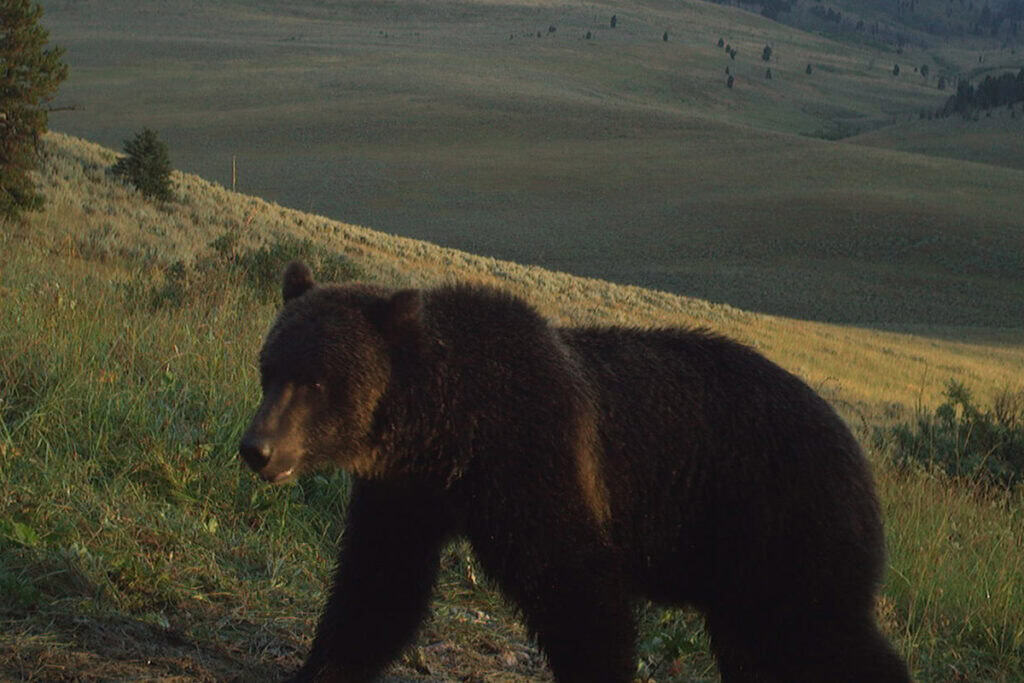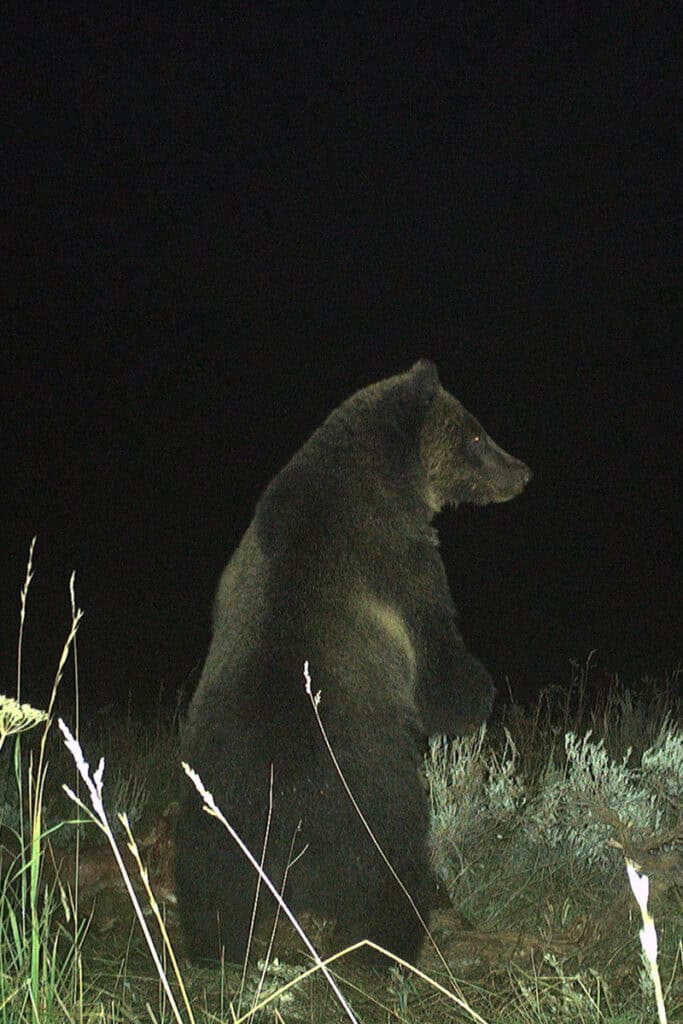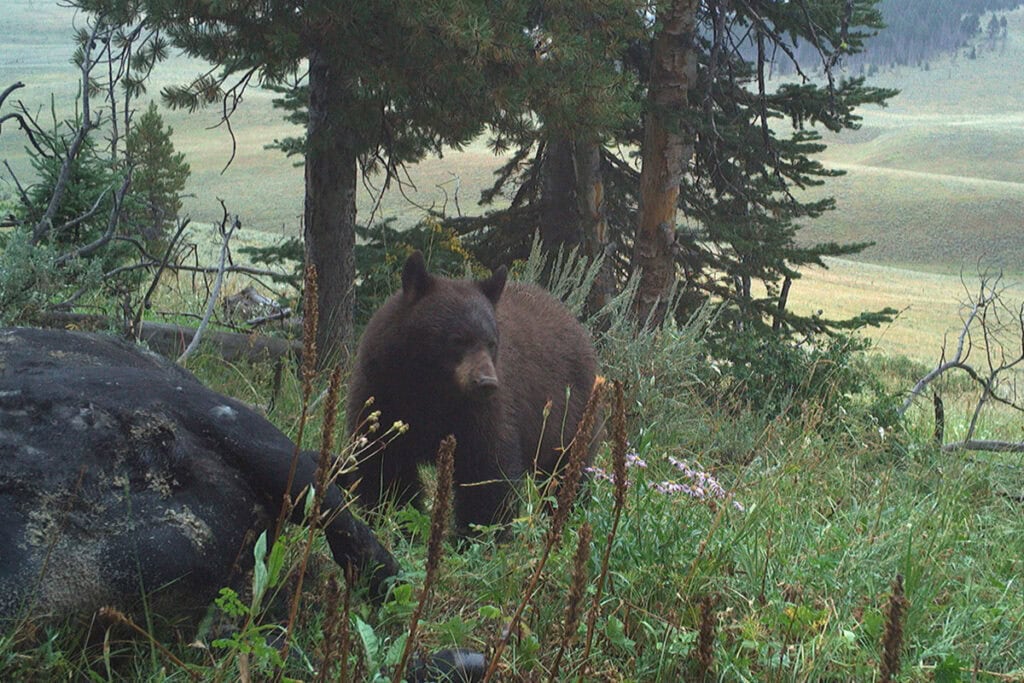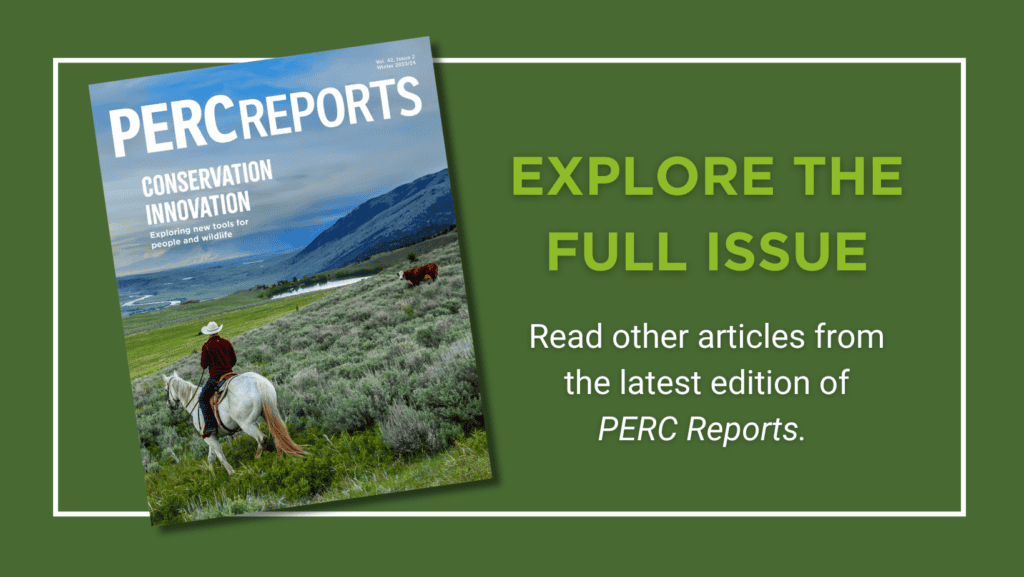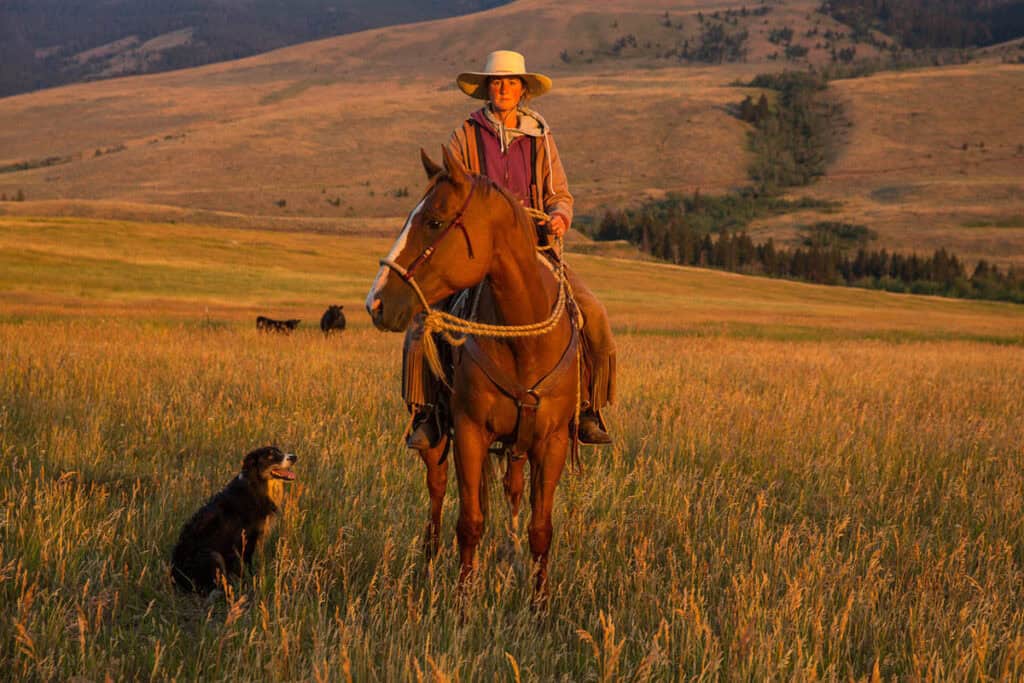
This special issue of PERC Reports features several pilot projects from PERC’s Conservation Innovation Lab. Read the full issue.
Our truck bounces as we climb a rutted two-track road toward a grassy ridge. We are following a four-wheeler driven by Hilary Anderson, a rancher who is our guide for the day to a sprawling expanse of Montana backcountry. We are there to repair a section of fence that spans a rugged stretch of national forest land where Anderson and her family graze cattle during the summer. Near the top, she stops and points at a cluster of trees above us.
“There’s a bear bed up there,” she says. She pulls out her phone to show us pictures of grizzly bears she captured on a nearby trail camera. Minutes later, when we reach the fenceline on the ridge, she shows us dig sites where grizzlies have been foraging for roots. Clouds roll in, and a light rain begins to fall. After giving us a quick lesson on fence repair, she hops back on her four-wheeler. Before driving away into the fog, she stops once more, with a question: “You all have bear spray, right?”
We’re in the West Fork drainage of Montana’s Gravelly Range—a key corridor for grizzly bears expanding out of Yellowstone National Park. Located just 40 miles west of the park, it’s places like this that have drawn bears in search of new territory after decades of absence from the landscape. It is also where conflicts between grizzlies, livestock, and people are on the rise. For generations, ranchers have raised livestock in this remote country, often with few or no grizzly encounters. But those days are no more.
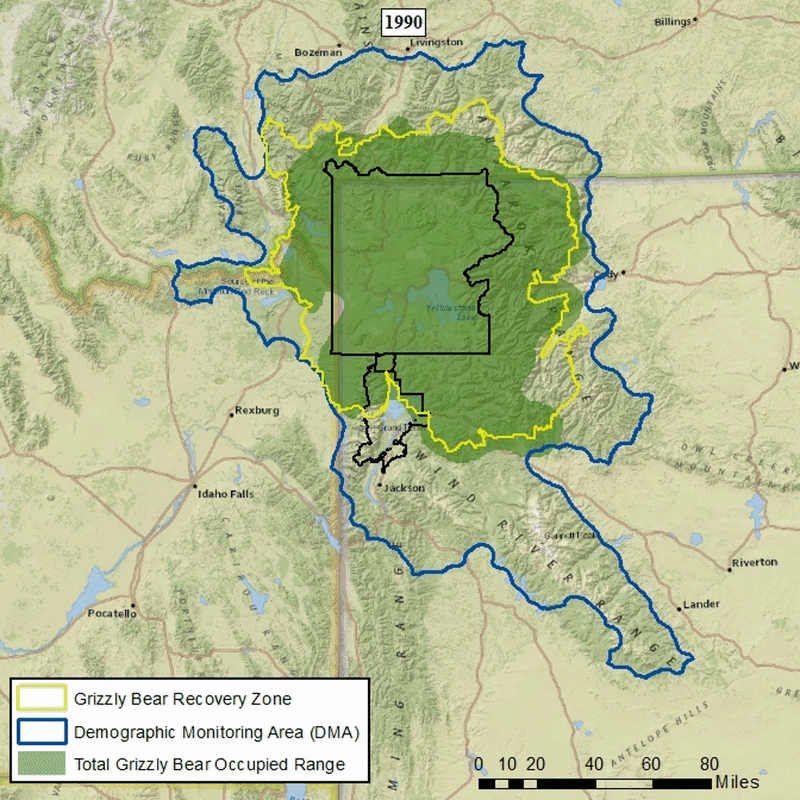
Today, as grizzly populations are growing, a new dilemma has emerged: Ranchers like the Andersons help keep vast areas of open space protected from development, providing vital habitat for wildlife. But the very species that benefit from this stewardship create significant challenges for ranchers. And in high-conflict areas like the West Fork, these wildlife challenges can push some ranchers to a breaking point.
In a world where wildlife issues often devolve into legal disputes or political battles, Anderson and her family are quietly honing a new approach to reducing conflict. With the support of PERC and other conservation organizations, they are experimenting with creative management practices to make livestock grazing more compatible with grizzly bears and other large predators. If successful, it could provide insights on how to make ranching more resilient in the face of all sorts of environmental and economic challenges.
Bear Necessities
For a rancher, Anderson seems to talk more about bears than cows. Her phone is filled with pictures of grizzlies from trail cameras set up throughout her pastures. She keeps careful records on the bears she and her family see while spending the summer watching over their cows deep in the Montana backcountry. Last summer, she estimated collecting 67 samples of bear scat—a fact her husband Andrew jokingly laments as the reason his horse’s saddlebags are always full. Each sample is sent off to researchers for DNA analysis.
But Anderson’s primary interest is not bears. Her approach to ranching is rooted in the idea of resilience. Prior to grazing on the West Fork, she and her husband ran livestock in the Tom Miner Basin, another predator hotspot outside of Yellowstone. There, they honed a set of livestock management practices designed to resist conflict with carnivores. Anderson worked as a range rider in the basin, tracking wildlife movements to help cattle avoid predation. Since then, finding ways to make ranching more resilient—whether to ecological, economic, or other external forces—has become something of a personal mission for her.
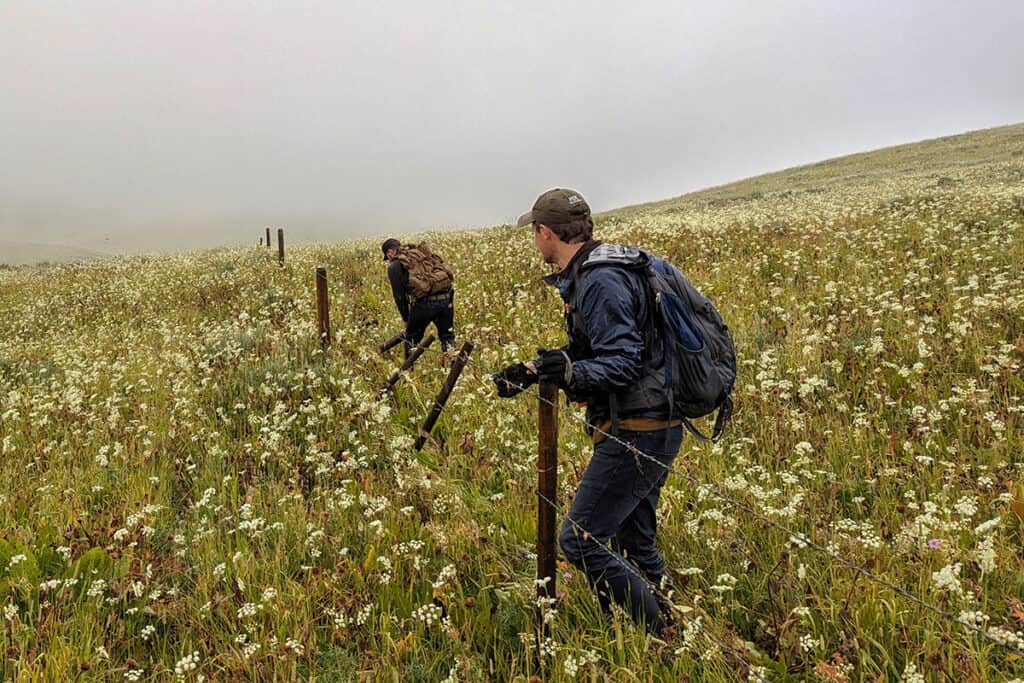
“When the ecosystem works, the business works,” Anderson says. “And when the business works, the ecosystem works.” That personal mission is why, when livestock depredations from grizzly bears reached new highs in the West Fork several years ago, the Andersons began considering whether they could be part of the solution. Their family was already running cattle part of the year on the nearby J Bar L Ranch in the Centennial Valley, so they were well aware of the predator issues in the Gravelly Range. Taking note of the challenges the rancher who held a lease to graze livestock on the West Fork was having, they approached the rancher and several conservation organizations with a bold idea.
Drawing from their experiences in the Tom Miner Basin, the Andersons proposed to buy the lease from the rancher and run cattle in ways that would let them coexist with carnivores. In 2022, the so-called “Grizzly Conflict Reduction Grazing Agreement” was sealed. The innovative, rancher-led effort aims to sustain livestock on this working landscape while minimizing conflicts with grizzlies and other wildlife. It’s a partnership between the Andersons and three conservation groups: the National Wildlife Federation, Greater Yellowstone Coalition, and PERC. Now, after two years of implementation, the early results are promising.
A Hotspot for Conflict
To understand the significance of the West Fork agreement, consider its unique setting and broader context. The area is public land managed by the U.S. Forest Service as a grazing allotment, which ranchers lease and typically use as summer pasture. Throughout the West, more than 200 million acres of federal lands are similarly leased for grazing, providing a critical source of forage for ranchers’ operations.
But the West Fork is no ordinary grazing allotment. In recent years, the area has become a magnet for grizzly conflicts. Livestock depredations on the allotment have increased significantly over the past decade, putting pressure on ranchers, the Forest Service, and state and federal wildlife agencies.
At the same time, the area has drawn interest from conservation groups working to recover grizzly bears, which are considered threatened under the Endangered Species Act. As a corridor for grizzlies dispersing out of Yellowstone, the Gravelly Range is crucial to connecting bears in and near the park with grizzlies elsewhere in Montana, providing the genetic exchange between distinct populations that agencies have said is needed to delist the species and return it to state management. But to do that means finding ways to reduce the costs of living with large carnivores like grizzlies.
When conflicts between grizzlies and livestock occur, everyone loses. Bears are euthanized or relocated, ranchers incur stress and financial losses, and in some cases the Forest Service might even close high-conflict areas to grazing and recreation. A few years ago, the agency closed two nearby trails to recreation after 20 grizzlies were documented feeding on cattle carcasses. Such conflict can also attract costly litigation from activist environmental groups who oppose livestock grazing on public lands, as is currently the case with several other Forest Service allotments near Yellowstone.
And then there’s the simple fact that grizzlies are dangerous to humans. Encounters with bears are increasingly common in this rugged terrain, which ranchers share with hunters, hikers, and other outdoor recreationists. Grizzly attacks have risen sharply in recent years, especially during hunting season. In the span of one week in 2019, four hunters were injured by grizzlies in separate incidents in the Gravelly Range. This past hunting season, a hunter shot and killed a grizzly in self defense not far from where we helped the Andersons fix a fence in the fog.
But grizzlies aren’t the only challenge for ranchers in this area. On our drive up the hillside, Anderson stopped to show us another quiet killer: tall larkspur, a purple-flowering plant that grows throughout much of the allotment. The plant is highly toxic to cows, which are attracted to it when it’s in bloom—typically from late June to late July. This only exacerbates the grizzly challenges. When cows die from larkspur poisoning, their carcasses attract grizzlies and other predators, creating even more opportunities for conflict.
“We are applying observations and lessons learned from our time on the land in new and different ways in hopes of generating new and better outcomes.”
— Hilary Anderson
After the West Fork allotment’s previous permittee lost 19 cattle to grizzlies a few years ago, the rancher decided he’d had enough. That’s where the Andersons came in. With the support of PERC and the other partners, the family eventually acquired the rancher’s grazing permit and agreed to implement a new set of livestock management strategies to minimize conflict on the allotment. The 12-year agreement with the partners functions like a forgivable loan. In exchange for helping acquire the lease, the Andersons will take strategic, hands-on steps to avoid grizzly-livestock interactions and reduce the likelihood that grizzlies are euthanized or removed from the landscape.
With two summer seasons now complete, there are encouraging signs that this new approach is working. In the first season under the new agreement, the Andersons lost only one cow to grizzlies—a loss rate of less than one quarter of a percent. The second year, in 2023, they lost none. “We are applying observations and lessons learned from our time on the land in new and different ways in hopes of generating new and better outcomes,” says Anderson.
Resilient Ranching
Hilary Anderson’s unique approach to ranching is directly informed by her experience on the land, especially her years as a range rider. After observing how elk avoided predation by clustering together in large numbers and moving constantly throughout the landscape, Anderson began to wonder if similar cattle-grazing strategies would reduce depredation in grizzly country. This experience formed the basis of the West Fork agreement, which relies on three primary strategies: moving cattle more frequently, grazing more cattle over a shorter period of time, and using range riders to manage predation.
“Wild ungulates [elk, bison, and other hoofed animals] don’t generally just camp out in the same area for a long time,” says Anderson. “They use strategic movement.” Under the agreement, the Andersons rotate their cows frequently to new pastures on the allotment—as often as once per week—to reduce the risk of conflict. This increased movement also improves grass, soil conditions, and riparian habitat, she says.
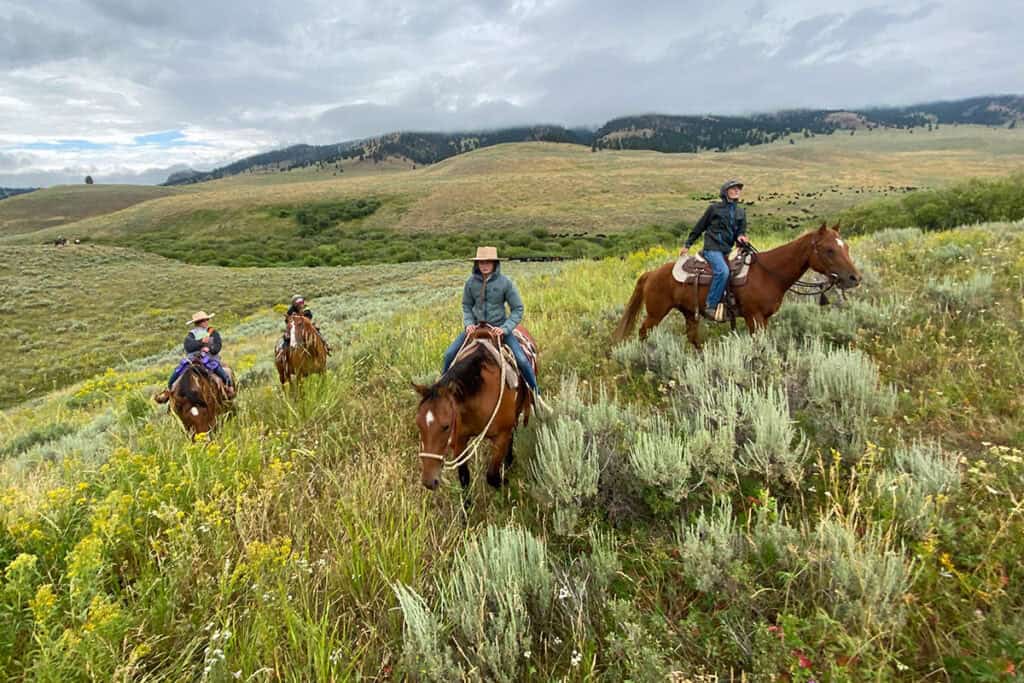
To further reduce predation risks, the Andersons have nearly doubled the number of cows on the allotment while reducing grazing time by half, running cattle for two months instead of four. Anderson says this approach makes cattle more formidable to grizzlies, who typically rely on picking off individual animals that are more widely dispersed. It also enables the Andersons to reduce the risk of larkspur poisoning by pushing the grazing season to later in the summer when the plant is no longer in full bloom. Fewer larkspur deaths means fewer cattle carcasses, which in turns means less grizzly conflict.
Compared to traditional grazing practices, the Andersons’ approach to resilient ranching requires lots of intensive hands-on management, including range riding. Anderson and her husband—including their four young kids—spend the summer months on the allotment managing the cows. That means navigating the West Fork’s rugged terrain, including 500-foot cliff walls, narrow canyons, dense timber, sage grasslands, bogs, and thick riparian areas. “At our lowest, we were riding five to six miles twice per day, for about three to four hours per ride,” says Anderson, recounting last year’s grazing season. “At our peak, we were riding between 20 and 23 miles per day, or eight to nine hours straight.”
If the Andersons’ resilient grazing strategies are successful at reducing wildlife conflicts over the long run, it could open up new opportunities for creative adaptation on other working landscapes facing similar challenges.
Anderson believes that delaying grazing until after the larkspur dries out has been one of the most effective strategies for minimizing livestock losses. The other involves moving cattle out of what she calls “areas of high vulnerability”—dense willow patches, riparian habitat, and other places where predation risks are greater. In addition to range riding, the Andersons use temporary electric fencing to direct cattle throughout the allotment and to better manage how and where cattle can access sensitive riparian areas.
While these strategies, fortunately, appear to be working, the agreement also stipulates that the Andersons will voluntarily move their cattle off the allotment for a season if conflicts exceed an agreed-upon threshold. This “off-ramp” provision gives all parties confidence that conflict reduction remains a top priority and encourages continuous adaptation if conditions change in ways that compromise wildlife or ranching.
Beyond the West Fork
The implications of this approach could extend far beyond the West Fork. If the Andersons’ resilient grazing strategies are successful at reducing wildlife conflicts over the long run, it could open up new opportunities for creative adaptation on other working landscapes facing similar challenges.
“The West Fork agreement highlights the persistence and partnerships required that are sometimes needed to address the chronic conflicts between livestock and wildlife,” says Kit Fischer, who runs the National Wildlife Federation’s Wildlife Conflict Resolution program. For three years, his organization worked closely with the Andersons to create the conflict-reduction partnership.
In areas with high levels of wildlife conflict, Fischer’s group often negotiates buyouts of ranchers’ grazing permits and works with federal agencies to retire the allotments from future grazing. When that option proved unworkable on the West Fork—due to reluctance from both the ranchers and the Forest Service to reduce the amount of land available for grazing—he sought a different approach with the support of PERC and the Greater Yellowstone Coalition.
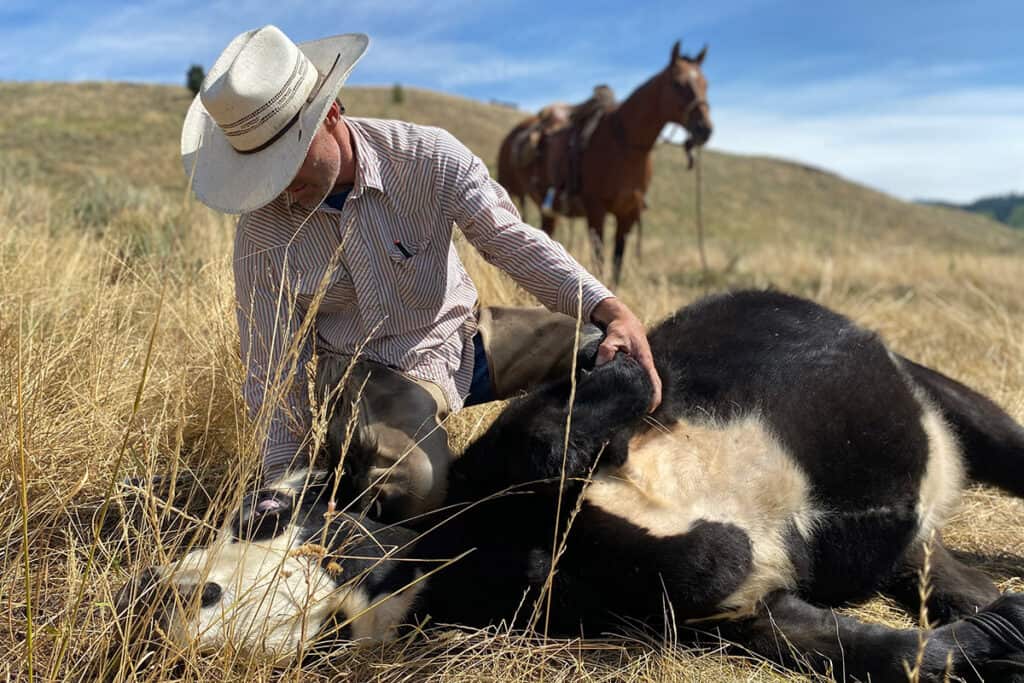
“It transformed into a new model for addressing conflicts on public grazing allotments,” says Fischer. Grazing agreements like this one, he says, are a practical solution for ranchers and wildlife advocates. “This market-based approach recognizes the economic value of public land livestock permits and fairly compensates ranchers for their leases while ensuring positive outcomes for wildlife.”
For Anderson, the agreement’s resilient ranching strategies make sense because they work. “The same things that make the land healthier also make the ranch more efficient and also make the cattle less vulnerable to predation,” she says. But in cases like this, it takes collaborations and partnerships to experiment with and refine the approach.
After we finished fixing the fence, we made our way back down the mountain. As we descended from the fog-shrouded hills, it was hard not to feel optimistic about the potential of this approach to reduce conflicts over western lands. The lessons learned in the West Fork could very well chart a course for a new era of collaborative conservation. We didn’t see any bears during our rainy two-day trek in the West Fork. But we did capture a glimpse of one potential future of ranching and wildlife conservation in the American West—a future that hinges on cooperation, adaptability, and a respect for the balance between human livelihoods and wildlife conservation.
